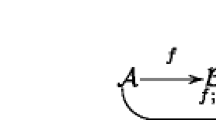Layered architectures are not flexible enough to cope with the dynamics of wireless dominated next generation communications. Cross-layer architectures may provide a more flexible solution: breaks the traditional structure by allowing interactions between two or more non-adjacent layers. This paper review the cross–layer approach to network architecture and compare the different cross-layering architectures, observing that most current approaches depend purely on local information and provide only poor and inaccurate information gathering at the global scale. This paper also explores the possible use of cross-layering architectures in autonomic communications and the potential importance of new cross-layer architectures with a hybrid local and global view for autonomic communications.











Similar content being viewed by others
REFERENCES
V. Srivastava and M. Motani, Cross-layer design: A survey and the road ahead, IEEE Communications Magazine, Vol. 43, No. 12, pp. 112–119, Dec. 2005.
J. O. Kephart and D. M. Chess, The vision of the autonomic computing, Computer, January, 2003.
S. Dobson, S. Denazis, A. Fernndez, D. Gaïti, E. Gelenbe, F. Massacci, P. Nixon, F. Saffre, N. Schmidt, and F. Zambonelli, A survey of autonomic communications, ACM Transactions on Autonomous and Adaptive Systems, Vol. 1, No. 2, December 2006. To appear.
D. G. Sachs, W. Yuan, C. J. Hughes, A. Harris, S. V. Adve, D. L. Jones, R. H. Kravets, and K. Nahrstedt, GRACE: A hierarchical adaptation framework for saving energy, ACEED 2005.
D. Kliazovich and F. Granelli, A cross-layer scheme for TCP performance improvement in wireless LANs, globecom 2004, IEEE Communications Society, pp. 841–844, 2004.
M. Conti, G. Maselli, G. Turi, S. Giordano, Cross layering in mobile Ad hoc network design, IEEE Computer Society, pp. 48–51, February 2004.
R. Winter, S. Schiller, N. Nikaein, and C. Bonnet, Cross talk: cross-layer decision support based on global knowledge, IEEE Communications, Vol. 44, No. 1, January 2006.
X. Gu, X. Fu, H. Tshofenig, and L. Wolf, Towards self-optimizing protocol stack for autonomic communication: initial experience, Proceedings of the 2nd IFIP International Workshop on Autonomic Communication, Springer Lecture Notes in Computer Science Vol. 3854 (LNCS), pp. 183–201, October, 2005.
V. T. Raisinghni and S. Iyer, Cross-layer optimisations in wireless protocol stacks, Computer Communications, Vol. 27, No. 2004, pp. 720–724, 2004.
S. Dobson, Putting meaning into the network: some semantic issues for the design of autonomic communications systems, Proceedings of the 1st IFIP Workshop on Autonomic Communications, volume 3457 of LNCS, Springer Verlag, pp. 207–216, 2005.
Z. H. Haas, Design methodologies for adaptive and multimedia networks, IEEE Communications Magazine, Vol. 39, No. 11, pp. 106–107, November 2001.
G. Wu, Y. Bai, J. Lai and A. Ogielski, Interactions between TCP and RLP in wireless Internet, Proc. IEEE GLOBECOM’99, Rio de Janeiro, Brazil, December 1999.
K. Chen, S. H. Shan, and K. Nahrstedt, Cross-Layer design for data accessibility in mobile ad hoc networks, Wireless Personal Communications, Vol. 21, No. 1, pp. 49–76, April 2002.
V. Kawadia and P. R. Kumar, A cautionary perspective on cross-layer design, IEEE Wireless Communications, February, pp. 3–11, 2005.
G. Wu, Y. Bai, J. Lai, and A. Ogielski, Interactions between TCP and RLP in wireless internet, Proceedings of IEEE GLOBECOM’99, Rio de Janeiro, Brazil, Dec. 1999.
P. Sudame and B. R. Badrinath, On providing support for protocol adaptation in mobile wireless networks, Mobile Networks and Applications, Vol. 6, No. 1, pp. 43–55, Jan. 2001.
B. -J. Kim, A network service providing wireless channel information for adaptive mobile applications: Part I: proposal, Proceedings of ICC’01, Helsinki, Finland, 2001.
Q. Wang and M. A. Abu-Rgheff, A multi-layer mobility management architecture using cross-layer signalling interactions, Proceeding of 5th European Personal Mobile Communications Conference, Glasgow, 2003.
V. T. Raisinghani and S. Iyer, ECLAIR: An efficient cross layer architecture for wireless protocol stacks, WWC2004.
Williamson and Q. Wu, A case for context-aware TCP/IP, Performance Evaluation Review, Vol. 29, No. 4, pp. 11–23, March 2002.
C. Sadler, W. Chen, and L. Kant, Cross-Layer Self-Healing in a Wireless Ad-Hoc Network, U.S. Patent filed April 2005.
Acknowledgments
This work is partially supported by Science Foundation Ireland under grant number 04/RPI/1544, “Secure and Predictable Pervasive Computing.”
Author information
Authors and Affiliations
Corresponding author
Additional information
Mohammad Abdur Razzaque is a PhD student in the School of Computer Science and Informatics at UCD Dublin. He holds bachelor’s and master’s degrees from the University of Dhaka in Bangladesh. His research focuses on the autonomic communications.
Simon Dobson is with UCD Dublin’s School of Computer Science and Informatics, where his research centres on the semantics of adaptive systems and the programming languages and methodologies used to create them. He has held academic and research posts at Trinity College Dublin and the CLRC Rutherford Appleton Laboratory, and for two years was CEO of a research based start-up company. He has published extensively in the fields of distributed and pervasive systems.
Paddy Nixon is Professor of Distributed Systems in the School of Computer Science and Informatics at UCD Dublin. His interests are in distributed and pervasive computing systems, supported by over 70 internationally reviewed papers. Prior to moving to UCD he was a professor at the University of Strathclyde and academic director of the Kelvin Institute, and academic/industrial partnership funded by the Scottish government.
Rights and permissions
About this article
Cite this article
Razzaque, M.A., Dobson, S. & Nixon, P. Cross-Layer Architectures for Autonomic Communications. J Netw Syst Manage 15, 13–27 (2007). https://doi.org/10.1007/s10922-006-9051-8
Published:
Issue Date:
DOI: https://doi.org/10.1007/s10922-006-9051-8




